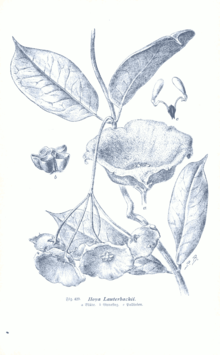Gogol expedition
The Gogol expedition of 1890/1891 was a German scientific expedition initiated by the New Guinea Company and sent to German New Guinea .
The botanist Karl Lauterbach set out on October 8, 1890, together with the station official of the New Guinea Company, Ludwig Kärnbach, from Finschhafen on an expedition to do botanical studies and set up collections. From the Astrolabebai the research trip continued into the valley of the Gogol River , which had been discovered by Georg von Schleinitz in 1886 . Since the Gogol was only navigable for a length of 14 km for steam launches, the participants pursued it on land 74 km upstream. They constantly struggled with malaria and fended off attacks from the locals.
The journey brought the realization that the Gogol forms the access to a large plain that extends south and west of the river. The Gogol Basin is connected to the coastal plain on the Astrolabebai by a narrow valley that is formed by the mountains that come close to the river and the mountain ranges that accompany the river in the north. The then densely forested Gogol plain has fertile, loamy soil and, like the mountain ranges on its left side, was relatively densely populated.
On November 26th, the research work had to be stopped because the participants were ill. Kärnbach's attempt to continue the explorations with part of the team failed. He returned to the expedition camp on the same day, totally exhausted. On December 1, the travelers started their way back to the mouth of the river, which they reached on December 4. On December 9th, 1890, the expedition ended prematurely with the arrival in Konstantinhafen .
Nevertheless, the trip brought many results in the natural sciences and ethnographic fields. Karl Lauterbach found the wax flower Hoya lauterbachii on November 10, 1890 on the Gogol . It was first described by Karl Schumann in January 1896 in the monthly magazine for cacti and was named after Lauterbach.
Lauterbach ended his stay in German New Guinea at the end of January 1891 and returned to Germany to evaluate the results.
Individual evidence
- ↑ not before November 6, 1890
- ^ Markus Schindlbeck: German scientific expeditions and research in the South Seas until 1914 . In: Hermann Joseph Hiery (ed.): The German South Sea. A manual . Verlag Ferdinand Schöningh, Paderborn 2001, pp. 132–155, ISBN 3-506-73912-3 , p. 142
- ↑ Karl Schumann, Ernst Gilg: Das Pflanzenreich, Hausschatz des Wissens . Verlag J. Neumann, Neudamm, 1900. Page 772. ( Hoya lauterbachii In: Das Pflanzenreich, Hausschatz des Wissens. )
